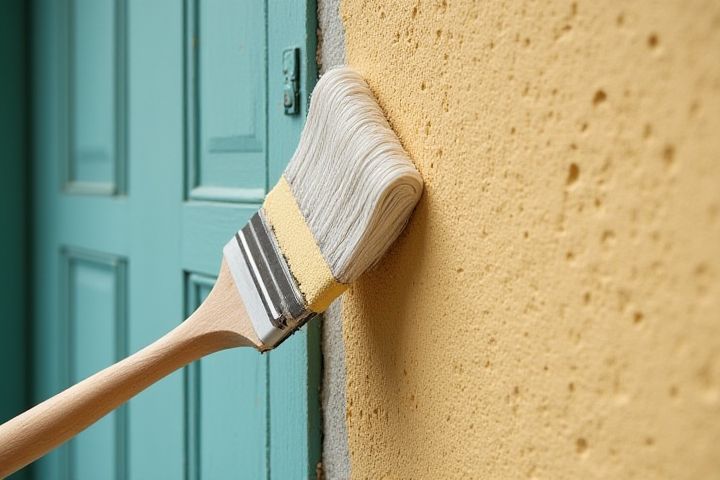
Painting your house exterior is essential for maintaining its aesthetic appeal and protecting it from environmental damage. Generally, it's recommended to repaint every 5 to 10 years, depending on factors like climate, the type of paint used, and the material of your siding. For example, wood siding may require more frequent repainting compared to vinyl or brick exteriors. Regular inspections for peeling, chipping, or fading can help you determine when it's time for a fresh coat. By staying proactive with maintenance, you can enhance your home's curb appeal and longevity.
How Often To Paint A House Exterior
Wood siding: every 3-7 years
For wood siding, it is crucial to repaint your home's exterior every 3 to 7 years to maintain its integrity and appearance. Factors such as climate, exposure to sunlight, and humidity levels can influence the frequency of this maintenance task. Regular inspections can help identify signs of wear, such as peeling or fading paint, which may prompt earlier repainting. By adhering to this time frame, you ensure that your wood siding remains protected against moisture and pests, prolonging its lifespan.
Aluminum siding: every 5 years
When it comes to maintaining aluminum siding, it is recommended to repaint your house exterior every five years. This timeframe ensures that the paint remains effective in protecting against weather elements, preventing rust and deterioration. Regular inspections can help identify signs of wear or fading, allowing you to address issues before they escalate. Keeping your aluminum siding well-painted not only enhances curb appeal but also contributes to the longevity and value of your home.
Stucco: every 5-6 years
Stucco exteriors typically require painting every 5 to 6 years to maintain their aesthetic appeal and protective qualities. Over time, exposure to harsh weather conditions, UV rays, and dirt can lead to fading and deterioration of the paint. Regular maintenance, including inspecting for cracks and wear, is essential to prolong the life of the paint and the stucco itself. By adhering to this schedule, you ensure your home remains visually appealing while protecting it from moisture and structural issues.
Brick: every 15-20 years
When it comes to maintaining the appearance of your brick home's exterior, painting should generally be done every 15 to 20 years. This timeline allows for the natural wear and tear of paint caused by environmental factors such as humidity, rainfall, and UV exposure to be fully accounted for. Keeping a watchful eye for peeling or fading can signal the need for a fresh coat. Regular upkeep not only enhances curb appeal but also protects the brick from moisture damage and other elements that can lead to deterioration.
Environment impact: affects frequency
The frequency of painting your house's exterior significantly hinges on environmental factors, such as regional climate, sunlight exposure, and humidity levels. In areas with intense sunlight, protective coatings may deteriorate faster, necessitating repainting every five to seven years to preserve your home's aesthetics and structural integrity. Conversely, homes in milder climates with lower humidity may require less frequent maintenance, potentially extending the interval to every seven to ten years. By considering these environmental influences, you can optimize your painting schedule while minimizing waste and promoting sustainability.
Quality of paint: influences durability
Quality of paint significantly influences the durability of your house's exterior, determining how frequently it needs to be repainted. High-quality, weather-resistant paints can last approximately 10 to 15 years, while lower-quality options may require repainting every 5 to 7 years due to fading and chipping. Factors such as climate, sun exposure, and surface material also play a critical role in the longevity of the paint job. Investing in premium paint not only enhances the visual appeal of your home but also saves you time and money in the long run by reducing the frequency of maintenance.
Proper surface preparation
Proper surface preparation is essential for the longevity and effectiveness of your house exterior paint. Ideally, you should paint your home every 5 to 10 years, depending on factors like climate, paint quality, and surface materials. Before painting, thoroughly clean the exterior, repair any damaged areas, and remove old paint to ensure optimal adhesion and durability. Investing time in this preparation will not only enhance the appearance of your home but also protect it from moisture, mold, and other environmental damage.
Climate conditions
Climate conditions significantly influence the frequency of painting your house exterior. In regions with extreme weather, such as intense sun exposure or heavy rainfall, you might need to repaint every 3 to 5 years to maintain your home's protection. Conversely, in milder climates, painting every 5 to 8 years may suffice, as the exterior is less exposed to damaging elements. Regular inspections can help you determine the best schedule, ensuring that your home's exterior remains both aesthetically pleasing and well-protected against the elements.
Material type variations
The frequency of painting a house's exterior largely depends on the material used. Wood siding typically requires repainting every 3 to 7 years due to its vulnerability to moisture and UV damage. In contrast, aluminum or vinyl siding may only need repainting every 10 to 15 years, as these materials are more durable and resist fading. For brick or stucco exteriors, you might paint every 15 to 20 years, which helps to preserve their aesthetic appeal while mitigating mold and mildew buildup.
Regular inspections for damage
Regular inspections for damage play a crucial role in determining how often to paint your house exterior. Typically, homes should be repainted every 5 to 10 years, but this can vary based on exposure to elements, type of siding, and local climate conditions. During inspections, look for signs of peeling, fading, or cracking paint, which indicate that your exterior may need fresh paint sooner. Maintaining an awareness of wear and tear not only enhances your home's curb appeal but also protects it from moisture-related damage and extends the life of your siding.
